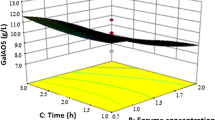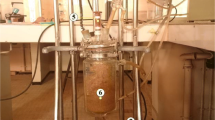Abstract
The valorization of biomass has become extremely important for the polymer industry to struggle with the depletion of oil. Solvothermal liquefaction is one method where the biomass can be converted to a useful ecopolyol. However, the conventional liquefaction process causes losses of time, material, and energy. This study aims at optimizing the liquefaction process of sugar beet pulp (SBP) using a response surface methodology (RSM) based on central composite design (CCD), as well as giving detailed insights into the physicochemical properties of the obtained ecopolyols. The synthesized ecopolyols were analyzed in terms of hydroxyl number, acid number, viscosity, and water content, and their structural properties characterized using infrared spectroscopy and thermogravimetric analysis. It was determined that the reaction temperature and catalyst loading were more important parameters than the reaction time on the liquefaction yield (LY) according to the ANOVA results (95% confidence level). The optimum conditions of solvothermal liquefaction for SBP, confirming through validation experiments, were 4.25% catalyst loading, a reaction time of 70 min, and a reaction temperature of 170 °C, resulting in a LY of 95%. The results show that the effect of reaction temperature and catalyst loading on hydroxyl number is more dominant than the reaction time, the most determinant parameter of acid number is catalyst loading, and the most determinant parameter of viscosity is the reaction temperature. The ecopolyols produced under optimal conditions display similar characteristic features (a 29.9±1.1 mg KOH/g acid number, a 299.8±3.6 mg KOH/g hydroxyl number, a 643.8±23.7 cP viscosity at 25 °C, and a 2.1±0.5% water content) to those of petroleum-based polyols widely preferred in the industry of polyurethane foam.











Similar content being viewed by others
References
Isikgor FH, Becer CR (2015) Lignocellulosic biomass: a sustainable platform for the production of bio-based chemicals and polymers. Polym Chem 6(25):4497–4559
Zhang J, Hori N, Takemura A (2019) Optimization of agricultural wastes liquefaction process and preparing bio-based polyurethane foams by the obtained polyols. Ind Crop Prod 138:111455. https://doi.org/10.1016/j.indcrop.2019.06.018
Scarsella M, de Caprariis B, Damizia M, De Filippis P (2020) Heterogeneous catalysts for hydrothermal liquefaction of lignocellulosic biomass: a review. Biomass Bioenergy 140:105662
Ye L, Zhang J, Zhao J, Tu S (2014) Liquefaction of bamboo shoot shell for the production of polyols. Bioresour Technol 153:147–153
Hadhoum L, Loubar K, Paraschiv M, Burnens G, Awad S, Tazerout M (2020) Optimization of oleaginous seeds liquefaction using response surface methodology. Biomass Conversion and Biorefinery 1–13. https://doi.org/10.1007/s13399-020-00681-6
Soares B, Gama N, Freire C, Barros-Timmons A, Brandão I, Silva R, Pascoal Neto C, Ferreira A (2014) Ecopolyol production from industrial cork powder via acid liquefaction using polyhydric alcohols. ACS Sustainable Chem Eng 2(4):846–854
Yan Y, Pang H, Yang X, Zhang R, Liao B (2008) Preparation and characterization of water-blown polyurethane foams from liquefied cornstalk polyol. J Appl Polym Sci 110(2):1099–1111
Wang H, Chen H-Z (2007) A novel method of utilizing the biomass resource: rapid liquefaction of wheat straw and preparation of biodegradable polyurethane foam (PUF). J Chin Inst Chem Eng 38(2):95–102
Chen F, Lu Z (2009) Liquefaction of wheat straw and preparation of rigid polyurethane foam from the liquefaction products. J Appl Polym Sci 111(1):508–516
Zhang Q, Chen W, Qu G, Lin X, Han D, Yan X, Zhang H (2019) Liquefaction of peanut shells with cation exchange resin and sulfuric acid as dual catalyst for the subsequent synthesis of rigid polyurethane foam. Polymers 11(6):993. https://doi.org/10.3390/polym11060993
Han S, Cui J, Gan L, Zhou X (2019) Effects of reaction conditions on the phenol liquefaction of peanut shells. BioResources 14(1):1899–1914
Fidan MS, Ertaş M (2020) Biobased rigid polyurethane foam prepared from apricot stone shell-based polyol for thermal insulation application, Part 1: Synthesis, chemical, and physical properties. BioResources 15(3):6061–6079
Zhang H, Ding F, Luo C, Xiong L, Chen X (2012) Liquefaction and characterization of acid hydrolysis residue of corncob in polyhydric alcohols. Ind Crop Prod 39:47–51
Wang Q, Tuohedi N (2020) Polyurethane foams and bio-polyols from liquefied cotton stalk agricultural waste. Sustainability 12(10):4214
Członka S, Strąkowska A, Kairytė A (2020) Application of walnut shells-derived biopolyol in the synthesis of rigid polyurethane foams. Materials 13(12):2687
Jiang W, Kumar A, Adamopoulos S (2018) Liquefaction of lignocellulosic materials and its applications in wood adhesives—a review. Ind Crop Prod 124:325–342
Ross A, Jones J, Kubacki M, Bridgeman T (2008) Classification of macroalgae as fuel and its thermochemical behaviour. Bioresour Technol 99(14):6494–6504
Zheng Z-Q, Liu Y, Li D, Wang L, Adhikari B, Chen XD (2017) Microwave-driven sugar beet pulp liquefaction in polyhydric alcohols. Int J Food Eng 13(7). https://doi.org/10.1515/ijfe-2016-0164
Jasiūnas L, Skvorčinskienė R, Miknius L (2020) Wet and coarse: the robustness of two-stage crude glycerol mediated solvothermal liquefaction of residual biomass. Waste Biomass Valori 11(5):2171–2181
Jasiūnas L, McKenna ST, Bridžiuvienė D, Miknius L (2020) Mechanical, thermal properties and stability of rigid polyurethane foams produced with crude-glycerol derived biomass biopolyols. J Polym Environ:1–12. https://doi.org/10.1007/s10924-020-01686-y
Myers RH, Montgomery DC, Anderson-Cook CM (2016) Response surface methodology: process and product optimization using designed experiments. John Wiley & Sons, Inc., Hoboken, New Jersey
Kohansal K, Tavasoli A, Bozorg A (2019) Using a hybrid-like supported catalyst to improve green fuel production through hydrothermal liquefaction of Scenedesmus obliquus microalgae. Bioresour Technol 277:136–147
Tran MH, Lee E (2020) Development and optimization of solvothermal liquefaction of marine macroalgae Saccharina japonica biomass for biopolyol and biopolyurethane production. J Ind Eng Chem 81:167–177
Yang H, Yan R, Chen H, Zheng C, Lee DH, Liang DT (2006) In-depth investigation of biomass pyrolysis based on three major components: hemicellulose, cellulose and lignin. Energy Fuel 20(1):388–393
Barbanera M, Pelosi C, Taddei A, Cotana F (2018) Optimization of bio-oil production from solid digestate by microwave-assisted liquefaction. Energy Convers Manag 171:1263–1272
Šereš Z, Gyura J, Filipović N, Simović DŠ (2005) Application of decolorization on sugar beet pulp in bread production. Eur Food Res Technol 221(1-2):54–60
Yılgın M, Duranay ND, Pehlivan D (2010) Co-pyrolysis of lignite and sugar beet pulp. Energy Convers Manag 51(5):1060–1064
Adiletta G, Brachi P, Riianova E, Crescitelli A, Miccio M, Kostryukova N (2020) A simplified biorefinery concept for the valorization of sugar beet pulp: Ecofriendly isolation of pectin as a step preceding torrefaction. Waste Biomass Valori 11(6):2721–2733
Mateus MM, Matos S, Guerreiro D, Debiagi P, Gaspar D, Ferreira O, Bordado JC, Galhano dos Santos R (2019) Liquefaction of almond husk for assessment as feedstock to obtain valuable bio-oils. Pure Appl Chem 91(7):1177–1190
Tan HT, Lee KT, Mohamed AR (2011) Pretreatment of lignocellulosic palm biomass using a solvent-ionic liquid [BMIM] Cl for glucose recovery: an optimisation study using response surface methodology. Carbohydr Polym 83(4):1862–1868
Wang Z-W, Liu X-L (2008) Medium optimization for antifungal active substances production from a newly isolated Paenibacillus sp. using response surface methodology. Bioresour Technol 99(17):8245–8251
Hong C, Wang Z, Si Y, Li Z, Xing Y, Hu J, Li Y (2020) Preparation of bio-oils by hydrothermal liquefaction (HTL) of penicillin fermentation residue (PR): optimization of conditions and mechanistic studies. Sci Total Environ:143216. https://doi.org/10.1016/j.scitotenv.2020.143216
Sidik DAB, Ngadi N, Amin NAS (2013) Optimization of lignin production from empty fruit bunch via liquefaction with ionic liquid. Bioresour Technol 135:690–696
Hu S, Wan C, Li Y (2012) Production and characterization of biopolyols and polyurethane foams from crude glycerol based liquefaction of soybean straw. Bioresour Technol 103(1):227–233
Hu S, Luo X, Li Y (2014) Polyols and polyurethanes from the liquefaction of lignocellulosic biomass. ChemSusChem 7(1):66–72. https://doi.org/10.1002/cssc.201300760
Ionescu M (2005) Chemistry and technology of polyols for polyurethanes. (1st ed.), Rapra Technology, Shawbury, Shrewsbury, Shropshire, U.K
Zhang H, Pang H, Zhang L, Chen X, Liao B (2013) Biodegradability of polyurethane foam from liquefied wood based polyols. J Polym Environ 21(2):329–334
Kosmela P, Gosz K, Kazimierski P, Hejna A, Haponiuk JT, Piszczyk Ł (2019) Chemical structures, rheological and physical properties of biopolyols prepared via solvothermal liquefaction of Enteromorpha and Zostera marina biomass. Cellulose 26(10):5893–5912
Amran UA, Zakaria S, Chia CH, Roslan R, Jaafar SNS, Salleh KM (2019) Polyols and rigid polyurethane foams derived from liquefied lignocellulosic and cellulosic biomass. Cellulose 26(5):3231–3246
Lee Y, Lee EY (2016) Liquefaction of red pine wood, pinus densiflora, biomass using peg-400-Blended crude glycerol for biopolyol and biopolyurethane production. J Wood Chem Technol 36(5):353–364
Lee SH, Teramoto Y, Shiraishi N (2002) Biodegradable polyurethane foam from liquefied waste paper and its thermal stability, biodegradability, and genotoxicity. J Appl Polym Sci 83(7):1482–1489
Luo X, Hu S, Zhang X, Li Y (2013) Thermochemical conversion of crude glycerol to biopolyols for the production of polyurethane foams. Bioresour Technol 139:323–329
Soares B, Gama N, Freire CS, Barros-Timmons A, Brandão I, Silva R, Neto CP, Ferreira A (2015) Spent coffee grounds as a renewable source for ecopolyols production. J Chem Technol Biotechnol 90(8):1480–1488
Li C, Luo X, Li T, Tong X, Li Y (2014) Polyurethane foams based on crude glycerol-derived biopolyols: One-pot preparation of biopolyols with branched fatty acid ester chains and its effects on foam formation and properties. Polymer 55(25):6529–6538
Briones R, Serrano L, Llano-Ponte R, Labidi J (2011) Polyols obtained from solvolysis liquefaction of biodiesel production solid residues. Chem Eng J 175:169–175
Krishnan JM, Deshpande AP, Kumar PS (2010) Rheology of complex fluids. Springer-Verlag, New York
Zheng Z-q, Wang L-j, Li D, Huang Z-g, Adhikari B, Chen XD (2016) Mechanical and thermal properties of polyurethane foams from liquefied sugar beet pulp. Int J Food Eng 12(9):911–919
Gosz K, Kowalkowska-Zedler D, Haponiuk J, Piszczyk Ł (2020) Liquefaction of alder wood as the source of renewable and sustainable polyols for preparation of polyurethane resins. Wood Sci Technol 54(1):103–121
Huang X-Y, Li F, Xie J-L, Cornelis F, Hse C-Y, Qi J-Q, Xiao H (2017) Microwave-assisted liquefaction of rape straw for the production of bio-oils. BioResources 12(1):1968–1981
Xu J, Xie X, Wang J, Jiang J (2016) Directional liquefaction coupling fractionation of lignocellulosic biomass for platform chemicals. Green Chem 18(10):3124–3138
Li G, Hse C, Qin T (2015) Wood liquefaction with phenol by microwave heating and FTIR evaluation. J For Res 26(4):1043–1048
Li F, Qiu C-P, Zhang X-L, Tan R-W, Cornelis F, Curole JP, Qi J-Q, Xiao H, Chen Y-Z, Xie J-L (2020) Effect of biomass source on the physico-mechanical properties of polyurethane foam produced by microwave-assisted liquefaction. BioResources 15(3):7034–7047
Akdogan E, Erdem M (2021) Improvement in physico-mechanical and structural properties of rigid polyurethane foam composites by the addition of sugar beet pulp as a reactive filler. J Polym Res 28(3):80. https://doi.org/10.1007/s10965-021-02445-w
Briones R, Serrano L, Labidi J (2012) Valorization of some lignocellulosic agro-industrial residues to obtain biopolyols. J Chem Technol Biotechnol 87(2):244–249
Acknowledgements
The authors acknowledge with appreciation the Flokser Textile Company for conducting the analysis of water content of ecopolyols.
Funding
This study was funded by Eskisehir Technical University Scientific Research Projects Commission under grant no 20DRP063.
Author information
Authors and Affiliations
Corresponding author
Ethics declarations
Conflict of interest
The authors declare no competing interests.
Additional information
Publisher’s Note
Springer Nature remains neutral with regard to jurisdictional claims in published maps and institutional affiliations.
Supplementary Information
ESM 1
(DOCX 4802 kb).
Rights and permissions
About this article
Cite this article
Erdem, M., Akdogan, E. & Bekki, A. Optimization and characterization studies on ecopolyol production from solvothermal acid-catalyzed liquefaction of sugar beet pulp using response surface methodology. Biomass Conv. Bioref. 13, 6925–6940 (2023). https://doi.org/10.1007/s13399-021-01579-7
Received:
Revised:
Accepted:
Published:
Issue Date:
DOI: https://doi.org/10.1007/s13399-021-01579-7




